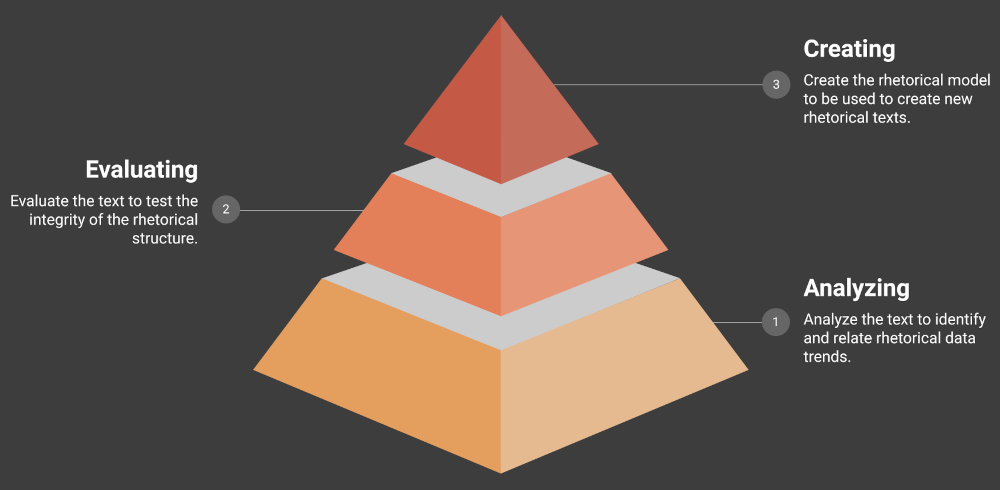Table of Contents
Have you ever dreamed about being able to argue as eloquently as Christopher Hitchens? Or maybe dismantle a bad argument as well as Jordan Peterson? Or deliver a speech as persuasively as President Barack Obama? Rhetorical modeling will help you.
What is a Rhetorical Modeling
Rhetorical Modeling: a process that provides sequential steps to perform a rhetorical analysis through data analysis. The process extracts a model that identifies the placement, frequency, and combination of multiple rhetorical concepts (appeals, devices, etc.) for maximum rhetorical effect. This derived rhetorical model can then be used for future, original rhetorical texts.
Example: The user needs to write and present a speech for class president.
- The user selects a presidential speech by President Obama to analyze.
- The user performs the required rhetorical data analysis steps to extract the model.
- Finally, the user uses the derived model to create their own modeled but original speech.
Why should I use Rhetorical Modeling
Using and/or studying the process provides a unique method to deeply understand and improve your rhetorical analysis skills. The process is designed to practice and enforce the higher-order thinking skills (top 3 skill tiers) of Bloom’s Taxonomy:

The table below clarifies the relationship between the Bloom’s taxonomy cognitive skills and the Rhetorical Modeling steps:
| # | Skill Name | Skill Description | Rhetorical Modeling |
|---|---|---|---|
| 4 | Analyzing | Take apart the known and identify relationships | Analyze the text to identify and relate rhetorical data trends |
| 5 | Evaluating | Examine information and make judgements | Evaluate the text to test the integrity of the rhetorical structure |
| 6 | Creating | Use information to create something new | Create the data model to be used to create new rhetorical texts |
What are the Rhetorical Modeling Process Steps
- Step 1: Analyze the rhetorical text to:
- structure the text into logical chunks (ex. argument map)
- perform a data analysis to identify the data trends of rhetorical concepts such as:
- line of reasoning
- rhetorical appeals
- appeal to ethos
- appeal to logos
- appeal to pathos
- rhetorical devices
- argument claim types
- fact claim
- policy claim
- value claim
- etc.
- Step 2: Evaluate the text to test the integrity of the rhetorical structure:
- counterargument
- alternate rhetorical choice(s)
- etc.
- Step 3: Create the rhetorical model to be used to create new rhetorical texts.
This process results in a reusable template for original texts and teaches the user to mix and match the different rhetorical concepts to improve their rhetoric.

Where can I apply the Rhetorical Modeling
This process can essentially be used to study and deeply understand many rhetorical situations. Some of the most useful situations that I recommend are:
- Speeches
- Advertisements
- Interviews
- Debates
- Essays
- Articles
- Comedy Bits
Rhetorical Analysis Data Dashboard Example
Here is an example of a rhetorical analysis data dashboard for rhetorical appeals. Let’s play around with the different filters available in the dashboard to see what data trends and information we can quickly derive from this analysis of a political speech by Vivek Ramaswamy.
- Use the Full Screen icon in the bottom right to expand the dashboard
- Use the bar or pie chart to filter by Appeal Type
- Use the Line of Reasoning to filter by Line of Reasoning
Rhetorical Modeling Learning Series
I’ll be creating a series of posts to explore this rhetorical analysis process. I’ll also be including free quizzes to help test your knowledge of the specific rhetorical concept that we’re covering. Here’s a list of the current categories of rhetorical models in progress:
